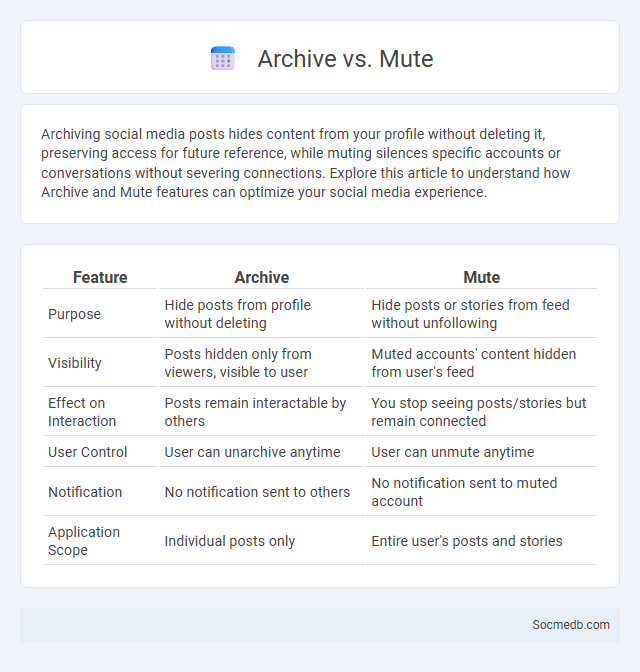
Photo illustration: Archive vs Mute
Archiving social media posts hides content from your profile without deleting it, preserving access for future reference, while muting silences specific accounts or conversations without severing connections. Explore this article to understand how Archive and Mute features can optimize your social media experience.
Table of Comparison
| Feature | Archive | Mute |
|---|---|---|
| Purpose | Hide posts from profile without deleting | Hide posts or stories from feed without unfollowing |
| Visibility | Posts hidden only from viewers, visible to user | Muted accounts' content hidden from user's feed |
| Effect on Interaction | Posts remain interactable by others | You stop seeing posts/stories but remain connected |
| User Control | User can unarchive anytime | User can unmute anytime |
| Notification | No notification sent to others | No notification sent to muted account |
| Application Scope | Individual posts only | Entire user's posts and stories |
Introduction to Managing Conversations
Managing conversations on social media requires strategic engagement and active listening to foster meaningful interactions. Employing tools like sentiment analysis and comment moderation enhances the quality of dialogue and safeguards brand reputation. Effective conversation management drives customer loyalty, resolves issues promptly, and amplifies positive user experiences.
What is Archive?
Archive in social media refers to the feature that allows users to hide posts from their profiles without deleting them, preserving content for private viewing. This function helps maintain a curated and organized profile while retaining access to past posts for future reference or reposting. Archives improve user control over their digital footprint by enabling temporary removal and easy restoration of content.
Understanding Mute Functions
Mute functions on social media platforms allow users to silence specific accounts or keywords without unfollowing or blocking them, enhancing user control over content visibility. This feature improves user experience by reducing unwanted content, minimizing exposure to negativity, and maintaining social connections discreetly. Popular platforms like Twitter, Instagram, and Facebook integrate mute options, supporting personalized content management and mental well-being.
Archive vs Mute: Key Differences
Archiving on social media hides posts or conversations from your main feed without deleting them, allowing you to revisit content later. Muting silences notifications or updates from specific users or groups without unfollowing or blocking, keeping your feed clutter-free. Understanding these features helps you manage your online experience effectively and maintain control over what appears in your social media interactions.
When to Use Archive
You should use the archive feature on social media to hide posts that are no longer relevant or represent outdated information without permanently deleting them. Archiving allows you to maintain your social media history while keeping your profile clean and focused on current content. It also helps manage your online presence by temporarily removing posts during rebranding or personal changes.
When to Use Mute
Knowing when to use mute on social media enhances your digital experience by allowing you to reduce distractions without unfollowing or causing offense. You might use mute during overwhelming conversations, temporary content overload, or when certain topics clash with your interests or mental well-being. Your decision to mute helps maintain a balanced feed while preserving connections and control over your social interactions.
Archive vs Archive: Common Misconceptions
Archive features on social media platforms often lead to confusion, with many users believing that archiving deletes content permanently, whereas it actually hides posts from your profile without removing them. Your archived content remains accessible only to you, preserving engagement data and allowing easy restoration at any time. Understanding this distinction prevents accidental loss of valuable memories and maintains control over your digital footprint.
Best Practices for Conversation Management
Effective conversation management on social media involves timely responses to user inquiries, maintaining a consistent brand voice, and actively monitoring platforms to address both positive and negative feedback. Utilizing social listening tools enhances the ability to track brand mentions and emerging trends, enabling proactive engagement that fosters community trust. Implementing clear guidelines for tone and escalation ensures seamless interactions and swift resolution of conflicts, promoting a positive user experience.
Pros and Cons: Archive and Mute Compared
Social media platforms offer Archive and Mute features to manage content visibility without unfollowing or blocking users. Archiving allows users to hide posts or stories from their profile, preserving privacy while maintaining access, whereas Muting silences updates from specific accounts in user feeds without notification. Both tools enhance user control over their social media experience, balancing content curation with relationship management.
Choosing the Right Option for You
Selecting the right social media platform depends on your specific goals, whether it's building a professional network, showcasing creative work, or engaging with communities. Consider factors like audience demographics, content format, and platform features to match your needs effectively. Tailoring your choice ensures your efforts resonate with your target audience and maximize your social media impact.
 socmedb.com
socmedb.com